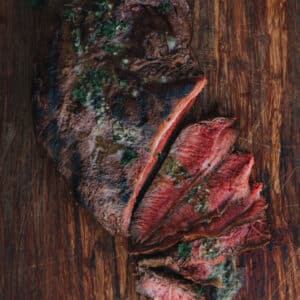Tired of the same old steaks? Discover the hidden gems of the meat world with our guide to butcher’s cuts. These are the prized pieces that butchers often keep for themselves – and for good reason.
Where a butcher cuts all steaks, not all steaks are coveted in the same way. Butcher’s cuts are the secret weapons of meat lovers. These lesser-known cuts of beef offer incredible flavor and tenderness, often at a fraction of the price of more famous cuts. From the succulent flat iron to the robust hanger steak, we’ll introduce you to cuts that’ll completely change your beef recipes.

Table of Contents
In this guide, we’ll walk you through:
- What makes these cuts special
- How to find them (hint: your local butcher is your new best friend)
- The best ways to prepare each cut for maximum deliciousness
What Is a Butcher’s Cut Steak?
A butcher’s cut steak isn’t an official meat label you’ll find at the grocery store. Instead, this type of steak is a term created by butchers and can come in any grade of beef. These cut’s are small and take a skilled butcher to cut from within the larger primal sections. Because of this, they are highly coveted.
In the pre-supermarket era, local butchers reigned supreme. With their deep knowledge of meat, these butchers sometimes kept choice cuts for themselves and their families, giving rise to the term “butcher’s cuts.”
Interestingly, some of these prized cuts came from muscles that might be initially overlooked, like the diaphragm (hanger steak). Despite any initial reservations, these cuts of beef often offered exceptional value. They were and still are deemed as some of the more affordable cuts of meat.
Key Characteristics of the Butcher’s Cut
- Hidden Gems: Often come from lesser-known sections of the primal cuts not typically displayed whole in stores.
- Packed with Flavor: Can pack a more intense beefy flavor due to the muscles they come from (butcher’s knowledge is vital for selecting the best cuts for steaks).
- Budget-Friendly: Because they might be less familiar, butcher’s cuts can be a more affordable way to enjoy delicious steaks.
- Versatile Cooking Options: To achieve optimal tenderness and flavor, some cuts may require different cooking methods than others (grilling, searing, marinades).
- Not One-Size-Fits-All: Each butcher’s cut has unique characteristics, so a little research or a chat with your butcher can go a long way.
The Best Butcher’s Cut Steaks
Hanger Steak
This unique cut of beef comes from the diaphragm muscle in the plate primal section of the cow, hence its French name “onglet,” which translates to “little tongue.” Don’t let the location deter you – hanger steak boasts an intensely beefy flavor and a juicy texture. It’s a favorite among chefs for its quick-cooking nature and shines when grilled or seared over high heat.
Hanger steak recipes
Flat Iron Steak
Nestled in the shoulder (aka the chuck primal), the flat iron steak (also known as flap meat) is a butcher’s cut gem. This tender cut is surprisingly easy to prepare. Thanks to its versatility, you can grill, pan-sear, or even experiment with other cooking methods to discover your favorite way to enjoy its deliciousness.
Flat Iron steak recipes
Skirt Steak
The name says it all! Skirt steak, located in the plate area, is a popular choice for fajitas or quick cooking high heat methods. This cut, with an inside and an outside option, delivers a bold, beefy flavor that pairs perfectly with marinades. Since it can be a bit tougher, marinating helps tenderize the meat, making it ideal for quick, high-heat cooking methods like grilling or stir-frying.
Flank Steak
Flank steak is a long, flat cut from the flank primal area of the cow. Known for its bold beefy flavor, it benefits from a good flank steak marinade and thrives with high-heat cooking methods like grilling or stir-frying. Just like a skirt steak, this cut has a unique grain, and it’s best to learn how to cut against the grain for the most tender, flavorful slices.
Flank Steak Recipes
Oyster Steak
Located in the round primal area, oyster steak is a unique cut nestled inside a cow’s hip on the Aitch bone. This little hidden gem, also called a spider steak, is shaped like a crescent moon and boasts beautiful marbling throughout, contributing to its rich flavor. With only two tiny Oyster steaks per cow, it’s a relatively rare find that’s well worth seeking out. Despite its petite size, this steak packs a punch in the flavor department, and its tenderness makes it perfect for a quick sear on the pan.
Teres Major
Also known as the shoulder tender or petite tender, the teres major is a hidden gem from the chuck primal. This cut is often compared to the tenderloin for its texture but offers a more robust beef flavor. Despite coming from a heavily used muscle, it remains tender due to its small size. The teres major is perfect when grilled or pan-seared to a steak temp of medium-rare, making it an excellent choice for steak lovers looking for a flavorful alternative to more common cuts.
Teres Major Recipes
Tips for Finding and Selecting Butcher’s Cuts
Local Butcher Shop
- Local butchers are meat connoisseurs. They stock a wider variety of cuts than grocery stores and possess in-depth knowledge about each one.
- Tell your butcher what you’re looking for (grilling, braising, etc.), and they can recommend the perfect butcher’s cut for your desired outcome.
- Some butchers offer custom cuts or butchering services. This allows you to get exactly the amount and type of meat you need for your recipe.
Grocery Store
- Don’t be afraid to explore unfamiliar cuts in the meat section. If you see something you don’t recognize, it might be a delicious butcher’s cut!
- The butcher at your grocery store is a valuable resource. Ask them about unfamiliar cuts, their origin in the animal, and recommended cooking methods.
- Don’t hesitate to ask questions! A good butcher is passionate about meat and happy to share their knowledge. The more you learn, the more confident you’ll be in selecting the perfect butcher’s cut for your next culinary adventure.
Ordering Online
Thanks to the internet, there are so many places to buy meat online. Use your top-notch research skills to locate butcher’s cuts and have them delivered to your door! We’re partial to Porter Road Butcher for these cuts, where they even draw attention to them for ya.

Cooking Butcher’s Cuts Like a Pro
Before you slap your butcher’s cut on the grill, in a pan, or roast it in the oven, you need to understand some essential cooking tips. Since these cuts are leaner, they greatly benefit from marinades to tenderize the meat. You could use a dry rub to tenderize the meat or use a steak tenderizer marinade to infuse the meat with flavor. It’s totally up to you and your preferences.
Butcher’s cuts are like the secret handshake of the steak world – a way to unlock delicious, flavorful, and potentially affordable steaks you might not have known about. They might require a little extra knowledge about cooking methods or a friendly chat with your butcher, but the payoff is a truly unique steak experience.
More Helpful Beef Guides for Meat Nerds
FAQs
Not necessarily “better,” but they offer a unique flavor profile and can be just as delicious! Butcher’s cuts often come from well-exercised muscles, resulting in a more intense beefy flavor compared to tenderloin cuts. They can also be a more affordable option than the popular ribeye steak or filet mignon.
It depends! Local butchers are a great place to start. They often have a wider variety of cuts and can recommend the perfect butcher’s cut for your desired preparation. At the grocery store, you might need to do a little exploring or ask the butcher for recommendations on unfamiliar cuts.
Not at all! While some butcher’s cuts might benefit from marinades to tenderize them, many are surprisingly tender due to the specific muscles they come from. A good butcher will know which cuts are naturally tender and which might need a little extra prep love.






























